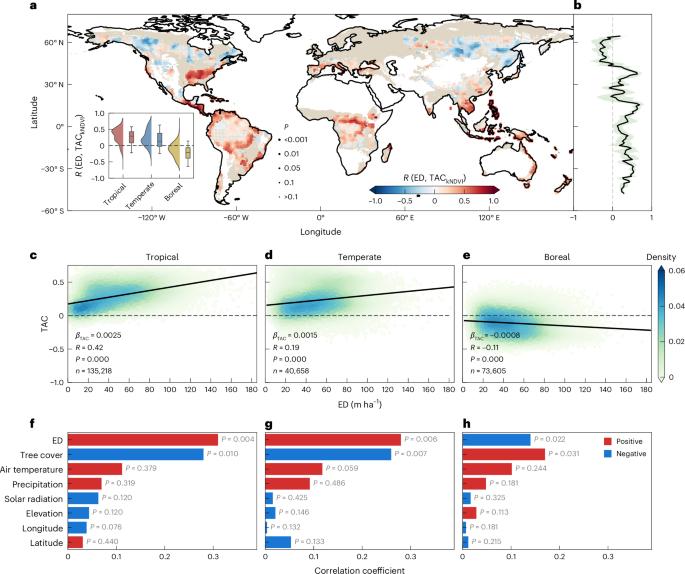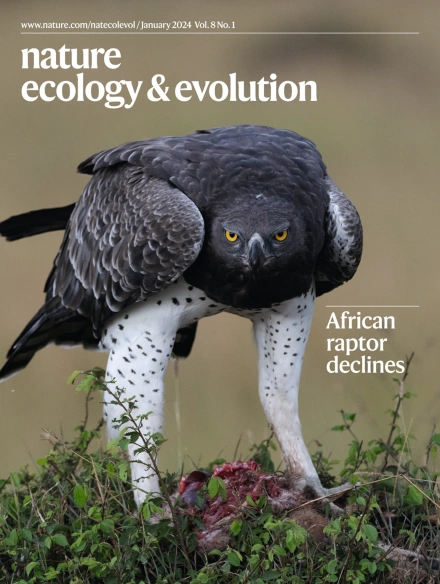Pervasive but biome-dependent relationship between fragmentation and resilience in forests
IF 13.9
1区 生物学
Q1 ECOLOGY
引用次数: 0
Abstract
The relationship between landscape fragmentation and vegetation resilience is uncertain. Here we use multiple satellite-based tree cover data and vegetation indices to quantify the apparent effects of fragmentation on global forest resilience and potential mechanisms thereof. We measure fragmentation as edge density, patch density and mean patch area of tree cover patches, and measure resilience as one-lag temporal autocorrelation of vegetation indices. We find a statistically significant (P < 0.05) fragmentation–resilience relationship in about 77% of fragmented forests, but the direction varies across biomes. In tropical and temperate forests, fragmentation is linked to increased local temperature and atmospheric dryness, resulting in a negative fragmentation–resilience relationship. Conversely, in boreal forests, fragmentation is associated with decreased atmospheric dryness and enhanced light resource, thereby increasing forest resilience. Our results reconcile competing hypotheses and highlight the importance of accounting for fragmentation when predicting shifts in ecosystem resilience under disturbances. These findings also suggest the necessity of biome-targeted forest management strategies for climate change mitigation and adaptation. Human-driven forest fragmentation could have major impacts on ecosystem functioning. This global analysis shows that the relationship between fragmentation and vegetation resilience in forests may differ depending on bioclimatic region and local environmental conditions.


森林破碎化与恢复力之间普遍但依赖于生物群落的关系
景观破碎化与植被恢复力之间的关系不确定。本文利用基于卫星的树木覆盖数据和植被指数来量化破碎化对全球森林恢复力的明显影响及其潜在机制。我们用边缘密度、斑块密度和平均斑块面积来衡量破碎性,用植被指数的单滞后时间自相关来衡量恢复力。我们发现,在约77%的破碎化森林中,破碎化与恢复力的关系具有统计学意义(P < 0.05),但方向在不同的生物群系中存在差异。在热带和温带森林中,破碎化与当地温度升高和大气干燥有关,导致破碎化与恢复力呈负相关。相反,在北方针叶林中,破碎化与大气干燥度降低和光照资源增强有关,从而提高了森林的恢复力。我们的结果调和了相互矛盾的假设,并强调了在预测干扰下生态系统恢复力变化时考虑碎片化的重要性。这些发现还表明,有必要制定以生物群落为目标的森林管理战略,以减缓和适应气候变化。
本文章由计算机程序翻译,如有差异,请以英文原文为准。
求助全文
约1分钟内获得全文
求助全文
来源期刊

Nature ecology & evolution
Agricultural and Biological Sciences-Ecology, Evolution, Behavior and Systematics
CiteScore
22.20
自引率
2.40%
发文量
282
期刊介绍:
Nature Ecology & Evolution is interested in the full spectrum of ecological and evolutionary biology, encompassing approaches at the molecular, organismal, population, community and ecosystem levels, as well as relevant parts of the social sciences. Nature Ecology & Evolution provides a place where all researchers and policymakers interested in all aspects of life's diversity can come together to learn about the most accomplished and significant advances in the field and to discuss topical issues. An online-only monthly journal, our broad scope ensures that the research published reaches the widest possible audience of scientists.
 求助内容:
求助内容: 应助结果提醒方式:
应助结果提醒方式:


